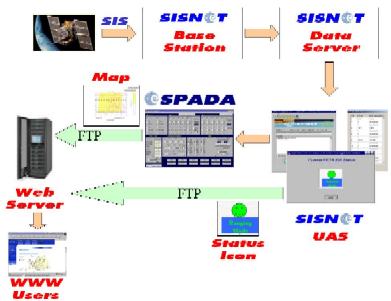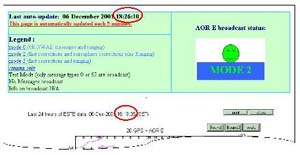|
Real-time
monitoring of the ESTB through the SISNeT technology
1.
How this service works?
2.
What does "last auto-update" mean?
3.
Must the time indication on the maps correspond with the "last auto-update"
indication?
4.
Which are the update rates of the page components?
5.
What does "Info N/A" mean?
6.
How can I send suggestions and comments?
7.
Is the system validated?
8.
Sometimes the performance map appears incomplete. What is the cause of
that problem and how to solve it?
1.
How this service works?
This service
is based on:
- The
SISNeT platform. Its mission is to provide access to the ESTB signals through
the Internet (the SISNeT articles and presentations included in
the publications section of this Website provide a global
view of the SISNeT platform). The ESA SISNeT User Application Software
(UAS) is able to connect to the SISNeT Data Server, and access the
ESTB signal-in-space (SIS) in real time. The UAS includes a set
of algorithms, able to calculate the ESTB SIS broadcast mode in
real time, and send it as an icon to the ESA Web Server.
- The
ESA ESPADA Software is an EGNOS simulation tool, optimised for co-operating with
the SISNeT UAS. ESPADA uses the real-time information provided by
SISNeT to produce ESTB performance maps in real time.
- The
ESA Web Server. Stores the web pages related to this service and all the linked
resources. Its main function is to allow users accessing the SISNeT/ESPADA
information using a web browser.

System block diagram
2.
What does "last auto-update" mean?
The
main objective of the web page is to act as an online real-time monitoring
tool. Therefore, the page must be refreshed automatically, in order
to show the most recent information.
The
"last auto-update" field indicates the instant of the last
refresh. That instant is identified by date and time (using the local
computer settings for date/time format), and just acts as a reference.
Looking at that field, you can know when the page was updated the last
time, and predict when the next refresh will take place. In addition,
you can easily detect if the page is not properly auto-refreshing by
observing that field.

"Last
auto-update" field
3.
Must the time indication on the maps correspond with the "last
auto-update" indication
Absolutely
no.
First
of all, the "last auto-update" field (LAUF) is related
to the web page, and is obtained from your system time. This is
reasonable, since the objective is to provide a reference of the last
automatic refresh…and what better reference than the local time
for that purpose! Obviously, that means on a given instant users in
different time zones will see different LAUF indications. And, of
course, if the system clock is not on time, an incorrect indication
will be shown.
On
the other hand, the time reference stamped on the map indicates its
time of production and, hence, it is exclusively related to the
maps.
Since:
- LAUF
is exclusively related to the web page;
- The
time-stamps are exclusively related to the map production time;
- The
web page and the map update rates are different.
It
can be concluded that there is no relationship between both time
indications.

Time
indications on the web page
4.
Which are the update rates of the page components?
There
are three auto-updated components in the web page:
- The
web page itself: it is refreshed each 5 minutes;
- The
broadcast mode icon: an updated version is generated each 5-6 minutes and sent
to the ESA web server;
- The
performance map: it is sent each 10 minutes (approx.) to the ESA web server.
Those
three components are independently updated, without any relationship
between them. The choice of updating the web page each 5 minutes is
reasonable, taking into account the icon/map update rates. Anyway, you
can always force the page to be refreshed, by simply using the "reload"
option of your web browser. You will appreciate that LAUF is updated
accordingly.
Under
certain anomalous situations, those rates might vary. For instance,
if the system switches to "Info N/A" state, that information
is immediately sent to the web server.
5.
What does "Info N/A" mean?
The
"Info N/A" status is set by the SISNeT system, and not by
the ESTB. Hence, the Info N/A status does not necessary means
the ESTB is not working properly. It must be understood as a status
in which SISNeT is not able to provide information (the broadcast
status and / or the performance maps). For instance if - due to a
major reason - any SISNeT functional block is disconnected, the system
will immediately detect it and activate Info N/A mode. The table bellow
summarises some of those possible scenarios, indicating which are
the elements affected by the "Info N/A" status. Note
the cause of the error is not reported by the web page.
|
Type
of failure
|
Comments
|
Broadcast
icon state
|
Performance
map state
|
|
Network
outage
|
The
ESTB monitoring application cannot receive the ESTB signals through
the ESA intranet. Hence, the broadcast status cannot be determined,
and the same happens with respect to the performance maps.
|
Info
N/A
|
Info
N/A
|
|
Broadcast
mode is 3, ranging, or internal test.
|
No
GIVE and/or UDRE information is available. Therefore, the ESA ESPADA
simulation tool cannot produce performance maps.
|
Mode
3 / ranging / internal test
|
Info
N/A
|
|
Any
SISNeT subsystem disconnected due to a major reason
|
Equivalent
to a network failure.
|
Info
N/A
|
Info
N/A
|
|
ESTB
temporarily broadcasting in an unknown mode
|
The
SISNeT monitoring application detects the failure immediately, and
sets the Info N/A mode
|
Info
N/A
|
Info
N/A
|
|
No
Signal-In-Space
|
Broadcast
status cannot be determined, and maps cannot be produced.
|
Info
N/A
|
Info
N/A
|
Typical
failures inducing the "Info N/A" status.
Note
some transient statuses may be reached. For instance, suppose the system
is working normally, and showing:
- ESTB
broadcasting in mode 2
- The
corresponding performance map
Suppose
the broadcast status changes to mode 3. The following is a probable transient
episode:
- 1) Within the next 5 minutes,
the SISNeT UAS will detect the change, and send a Mode 3 status icon
to the Web Server. ESPADA software is not able to continue working,
since mode 3 avoids obtaining the needed information. An Info N/A indication
substitutes the performance map.
Now,
say that the broadcast status returns again to mode 2. The transient occurs
as follows:
- 2)
Within the next 5 minutes, the SISNeT UAS detects the change, and send
a Mode 2 status icon to the Web Server.
- 3) ESPADA starts collecting data
and restarting the normal simulation activity. This can take 10-15 minutes.
- 4) ESPADA provides the first
map after the change. The web page shows the map, and continues working
normally.
From
the user's point of view, the complete episode occurs as shown in the
table bellow. SISNeT properly handles any possible transient state, so
that the user will always see a coherent indication of the system status.
|
Step
|
Broadcast
icon state
|
Performance
map state
|
|
Initial
status
|
Mode
2
|
Showing
a map
|
|
1
|
Mode
3
|
Info
N/A
|
|
2
|
Mode
2
|
Info
N/A
|
|
3
|
Mode
2
|
Info
N/A
|
|
4
|
Mode
2
|
Showing
a map
|
Transient
example from the user's point of view
6.
How can I send suggestions and comments?
Suggestions
and bug reports are welcome. Please, send them to the ESTB Helpdesk.
7.
Is the system validated?
The
system test/debug tasks started in November 2001. The complexity of such
activities is extremely high, since a big amount of aspects must be covered
and the main goal is to provide a high-quality service. Since November
2001, more than 15 major improvements have been made. The following are
some of the benefits derived from the test/debug activities:
- Unscheduled
service outages mitigated.
- Coherency
of the information.
- Advanced
algorithms for smart detection of Info N/A status
- Advanced
synchronisation with the ESA ESPADA simulation tool.
The
system will remain operational while finishing the testing/debugging activities.
During that period, a warning is shown (both in the status bar of the
web page and above the performance map), reminding the page is under test.
That means the system can provide temporary incoherent information. Once
the debugging activities are finished, the warning will be removed, and
that limitation will disappear.
8.
Sometimes the performance map appears incomplete. What is the cause of
that problem and how to solve it?
The
performance map must show a lot of information, using a limited space
and high-quality graphics. That involves the transference of big amounts
of data through the SISNeT network. The image files have been optimised
to quickly load from a Web browser. However, the transference from the
SISNeT UAS to the ESA Web server can be affected by network delays, making
some data transferences longer than expected, in terms of time. If the
web page refreshes just while the performance map image is being uploaded
to the Web Server, the user may see an incomplete map. You can find the
same effect in the World Wide Web, when accessing a website that is being
updated with big image files.
This
problem can be easily solved, by simply forcing a refresh of the web page
(using the "reload" option of the Web browser).
Last update: 9 July 2002
|

